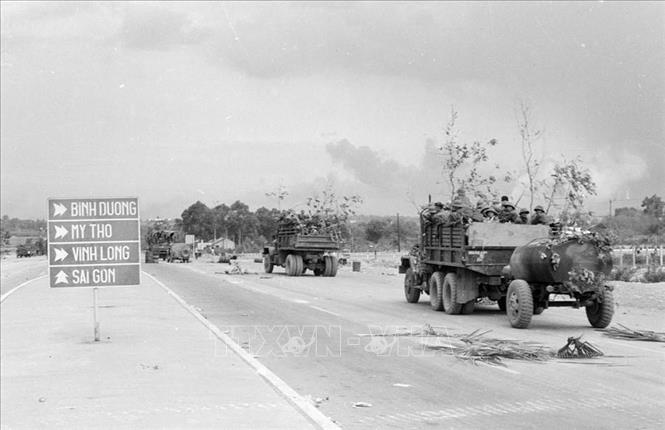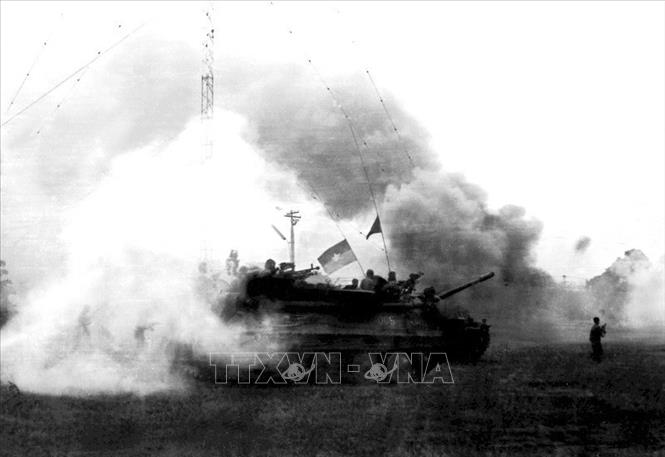
Liberation Army enters Saigon on Bien Hoa highway. Photo: Vu Tao/VNA
The armed forces of Military Region 9 opened fire and attacked, causing heavy damage to Ba Cang sub-region, Binh Minh sub-region, Dong Thanh sub-region, destroying and forcing the withdrawal of 13 posts, liberating a section of the southern bank of the Hau River. Local troops in Vinh Long destroyed the rear base of the security battalion and My Thuan sub-region, forcing the withdrawal of 12 posts. The liberation army used 105mm artillery captured from the enemy to fire at Binh Minh sub-region, Cai Von training school, Tra Noc airport, Phong Dinh sub-region, the US Consulate General in Can Tho , the Command Headquarters of Military Region 4 - Army Corps 4, and the private residence of Commander of Tactical Zone 4 Nguyen Khoa Nam.
Along with the activities of the Southwest Wing Corps and the armed forces of Military Region 8 on Route 4, the attacks of Military Region 9 on the Can Tho and Vinh Tra fronts contributed to holding the enemy in place, gradually isolating the Mekong Delta from Saigon city.
On the same day, the Standing Committee of the Saigon-Gia Dinh City Party Committee issued a Resolution to urgently prepare for the Saigon-Gia Dinh Liberation Campaign.
On the afternoon of April 12, 1975, in a meeting between the Campaign Command and a number of senior officers at the Command Headquarters, there was a proposal to name the campaign to liberate Saigon city after Uncle Ho. That was a demonstration of the infinite love of the entire Party, the entire people and the entire army for Uncle Ho, the belief and will to win of the army and people of the whole country, and also a way to express Uncle Ho's heart for his fellow countrymen in the South, who were always "in his heart". The Campaign Command unanimously sent a telegram to the Politburo asking to name the general offensive and uprising campaign to liberate Saigon, the largest-scale campaign with the deepest historical significance in the war of national liberation, the Ho Chi Minh Campaign... At 7:00 p.m. on April 14, 1975, the Politburo's telegram No. 37/TK was sent to the front, with the full text as follows: "Agree to name the Saigon Campaign the Ho Chi Minh Campaign".
In another development, to be determined to keep Xuan Loc, on April 12, 1975, the enemy hastily landed the 1st Airborne Brigade from Saigon to Tan Phong intersection. In the following days, they rearranged their formation in the town and sent the 3rd Marine Corps, the 318th Special Forces Battalion to Trang Bom, the 322nd Special Forces Battalion to Bau Ca, the 315th Battalion to Bau Han, Hill 122, and the 8th Regiment of the 5th Battalion from Lai Khe to Bau Ca.

On April 9, 1975, infantry and tank units rapidly advanced to liberate Xuan Loc, the “steel door” – the enemy’s key defensive base protecting Saigon from the Northeast. On April 21, enemy troops in Xuan Loc fled, and the gateway to Saigon from the Northeast was opened. Photo: VNA file
Thus, the enemy concentrated in this area 50% of the infantry force, 60% of the artillery and most of the tanks and armored vehicles of the 1st Corps along with the total reserve force equivalent to 1 division. The air force at Bien Hoa and Tan Son Nhat airports was mobilized an average of 80 times/day to directly support the counterattacks. The enemy also used CBU bombs, a type of bomb with great destructive power, banned in the world , to prevent our attack.
The battle in Xuan Loc was extremely fierce. After 3 days of fighting, although we had captured a number of targets, destroyed a part of the enemy's forces and held a number of important footholds, we had not yet completely destroyed a single battalion of them.
Based on the basic assumption that Xuan Loc is only valuable when connected to Bien Hoa, the Campaign Command decided to establish a new battle formation, isolating and cutting off Xuan Loc from Bien Hoa by capturing Dau Giay intersection, cutting off Route 1 to block the enemy from Trang Bom, capturing Tan Phong, cutting off Route 2 to Ba Ria. Implementing the above policy, the Campaign Command decided to temporarily stop attacking the town, leaving only a small part of the force to hold the occupied areas and restrain the enemy's diversionary tactics, while the majority of the force moved out, organized to gain experience, changed the way of fighting to liberate Xuan Loc.
---------------------------------------
[ Source: VNA; People's Army Newspaper 1995; Historic moments of the Ho Chi Minh campaign, People's Army Publishing House, Hanoi 2005; Great Spring Victory, People's Army Publishing House, Hanoi 2024 ]
Thuy Linh/VNA (synthesis)
Source: https://baotintuc.vn/nhan-vat-su-kien/ngay-1241975-quan-ta-mo-thong-hanh-lang-noi-lien-mien-dong-nam-bo-voi-dong-thap-muoi-20250412065409669.htm


![[Photo] National Assembly Chairman Tran Thanh Man chairs the 8th Conference of full-time National Assembly deputies](https://vphoto.vietnam.vn/thumb/1200x675/vietnam/resource/IMAGE/2025/9/29/2c21459bc38d44ffaacd679ab9a0477c)
![[Photo] General Secretary To Lam attends the ceremony to celebrate the 80th anniversary of the post and telecommunications sector and the 66th anniversary of the science and technology sector.](https://vphoto.vietnam.vn/thumb/1200x675/vietnam/resource/IMAGE/2025/9/29/8e86b39b8fe44121a2b14a031f4cef46)
![[Photo] General Secretary To Lam receives US Ambassador to Vietnam Marc Knapper](https://vphoto.vietnam.vn/thumb/1200x675/vietnam/resource/IMAGE/2025/9/29/c8fd0761aa184da7814aee57d87c49b3)


![[Photo] Many streets in Hanoi were flooded due to the effects of storm Bualoi](https://vphoto.vietnam.vn/thumb/1200x675/vietnam/resource/IMAGE/2025/9/29/18b658aa0fa2495c927ade4bbe0096df)




























































































Comment (0)